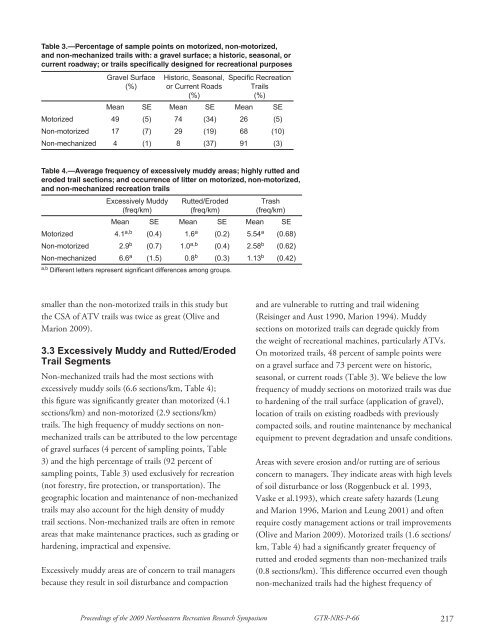Proceedings of the 2009 northeastern recreation research symposium
Proceedings of the 2009 northeastern recreation research symposium
Proceedings of the 2009 northeastern recreation research symposium
Create successful ePaper yourself
Turn your PDF publications into a flip-book with our unique Google optimized e-Paper software.
Table 3.—Percentage <strong>of</strong> sample points on motorized, non-motorized,<br />
and non-mechanized trails with: a gravel surface; a historic, seasonal, or<br />
current roadway; or trails specifi cally designed for <strong>recreation</strong>al purposes<br />
Gravel Surface<br />
(%)<br />
Historic, Seasonal,<br />
or Current Roads<br />
(%)<br />
smaller than <strong>the</strong> non-motorized trails in this study but<br />
<strong>the</strong> CSA <strong>of</strong> ATV trails was twice as great (Olive and<br />
Marion <strong>2009</strong>).<br />
3.3 Excessively Muddy and Rutted/Eroded<br />
Trail Segments<br />
Non-mechanized trails had <strong>the</strong> most sections with<br />
excessively muddy soils (6.6 sections/km, Table 4);<br />
this fi gure was signifi cantly greater than motorized (4.1<br />
sections/km) and non-motorized (2.9 sections/km)<br />
trails. Th e high frequency <strong>of</strong> muddy sections on nonmechanized<br />
trails can be attributed to <strong>the</strong> low percentage<br />
<strong>of</strong> gravel surfaces (4 percent <strong>of</strong> sampling points, Table<br />
3) and <strong>the</strong> high percentage <strong>of</strong> trails (92 percent <strong>of</strong><br />
sampling points, Table 3) used exclusively for <strong>recreation</strong><br />
(not forestry, fi re protection, or transportation). Th e<br />
geographic location and maintenance <strong>of</strong> non-mechanized<br />
trails may also account for <strong>the</strong> high density <strong>of</strong> muddy<br />
trail sections. Non-mechanized trails are <strong>of</strong>ten in remote<br />
areas that make maintenance practices, such as grading or<br />
hardening, impractical and expensive.<br />
Excessively muddy areas are <strong>of</strong> concern to trail managers<br />
because <strong>the</strong>y result in soil disturbance and compaction<br />
Specifi c Recreation<br />
Trails<br />
(%)<br />
Mean SE Mean SE Mean SE<br />
Motorized 49 (5) 74 (34) 26 (5)<br />
Non-motorized 17 (7) 29 (19) 68 (10)<br />
Non-mechanized 4 (1) 8 (37) 91 (3)<br />
Table 4.—Average frequency <strong>of</strong> excessively muddy areas; highly rutted and<br />
eroded trail sections; and occurrence <strong>of</strong> litter on motorized, non-motorized,<br />
and non-mechanized <strong>recreation</strong> trails<br />
Excessively Muddy<br />
(freq/km)<br />
Rutted/Eroded<br />
(freq/km)<br />
Trash<br />
(freq/km)<br />
Mean SE Mean SE Mean SE<br />
Motorized 4.1a,b (0.4) 1.6a (0.2) 5.54a (0.68)<br />
Non-motorized 2.9b (0.7) 1.0a,b (0.4) 2.58b (0.62)<br />
Non-mechanized 6.6a (1.5) 0.8b (0.3) 1.13b (0.42)<br />
a,b Different letters represent signifi cant differences among groups.<br />
and are vulnerable to rutting and trail widening<br />
(Reisinger and Aust 1990, Marion 1994). Muddy<br />
sections on motorized trails can degrade quickly from<br />
<strong>the</strong> weight <strong>of</strong> <strong>recreation</strong>al machines, particularly ATVs.<br />
On motorized trails, 48 percent <strong>of</strong> sample points were<br />
on a gravel surface and 73 percent were on historic,<br />
seasonal, or current roads (Table 3). We believe <strong>the</strong> low<br />
frequency <strong>of</strong> muddy sections on motorized trails was due<br />
to hardening <strong>of</strong> <strong>the</strong> trail surface (application <strong>of</strong> gravel),<br />
location <strong>of</strong> trails on existing roadbeds with previously<br />
compacted soils, and routine maintenance by mechanical<br />
equipment to prevent degradation and unsafe conditions.<br />
Areas with severe erosion and/or rutting are <strong>of</strong> serious<br />
concern to managers. Th ey indicate areas with high levels<br />
<strong>of</strong> soil disturbance or loss (Roggenbuck et al. 1993,<br />
Vaske et al.1993), which create safety hazards (Leung<br />
and Marion 1996, Marion and Leung 2001) and <strong>of</strong>ten<br />
require costly management actions or trail improvements<br />
(Olive and Marion <strong>2009</strong>). Motorized trails (1.6 sections/<br />
km, Table 4) had a signifi cantly greater frequency <strong>of</strong><br />
rutted and eroded segments than non-mechanized trails<br />
(0.8 sections/km). Th is diff erence occurred even though<br />
non-mechanized trails had <strong>the</strong> highest frequency <strong>of</strong><br />
<strong>Proceedings</strong> <strong>of</strong> <strong>the</strong> <strong>2009</strong> Nor<strong>the</strong>astern Recreation Research Symposium GTR-NRS-P-66<br />
217
















